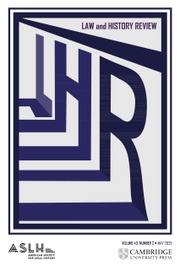Lawmaking in Dutch Sri Lanka’s cover is adorned by one of Jan Brandes’ (1743–1808) famous watercolours—a large tree, a small house in the background, and two obscure figures, presumably planting the soil of their garden. This supposed idyllic image is one of the focal points of Nadeera Rupesinghe’s rigorous study of law, landownership, and the complicated relationship between the colonizing Dutch and the colonized locals in eighteenth -century Sri Lanka. Rupesinghe’s book centres the Landraad, or Land Council: a legal forum set up by the Dutch East India Company (VOC) dealing with land management. Crucial to the Company’s control over the vast coastal areas and people they had conquered, these judicial forums were established from the 1740s onwards in the main commandments of Dutch Sri Lanka. Rupesinghe singles out the Galle Landraad, an important southern port of the Dutch until they were ousted from the island by the British in the 1790s. While this legal institution was primarily established as an instrument for colonial domination, in practice it became the primary place where locals could settle disputes around landownership. Rupesinghe calls it ‘a site for negotiation between the Sinhalese, other locals, and the VOC (…). Yet this process was mired in uncertainty and confusion, and lacked a clear trajectory’ (259). By emphasizing the lived experience of the litigants, councilors, and others who were roped into the legal theatre of the Landraad, Rupesinghe complicates our view of colonial law—not as a mere imposition of Dutch-Roman law, but as actively mediated, applied, and sometimes resisted. Through the concept of legal pluralism, ‘the existence of two or more legal systems in varying degrees of synchronism’ (27), she demonstrates the complexities of colonial rule in early-modern Sri Lanka.
The first three chapters of the book scrupulously set up the stage of the Landraad. Chapter 1 deals with the creation of the institution and its precolonial influences. While the institution was a Dutch invention, Sri Lankan locals were not unfamiliar with village tribunals and calling upon a higher (judicial-like) power to claim their rights. Furthermore, the Landraad’s primary task of land registration in the thombo, an intricate land-cadastre unique to Sri Lanka that listed landowners, their families, holdings, taxes, and social identification, had a clear precursor in the indigenous lēkam miti, land rolls written on palm leaves maintained for the local kings. Chapters 2 and 3 fill this stage with the people who participated in the Landraad. First, by looking at the councilors: a mix of European(ized) VOC officials and native chiefs. The latter group held an ambiguous role in the meetings of the council. On the one hand, they did not have the power to vote in decisions. On the other hand, Rupesinghe finds their opinions on local customs and laws mentioned in the final verdicts that were passed by the council. Perhaps this is why a wide variety of locals—Sinhalese, Tamils, Muslims, Malays, Chettiars, manumitted people—were not deterred from fighting for their rights in this legal arena. From sample years it becomes clear that women made up around 27 % of the litigants and that lack of status was not an eliminating factor when facing the law. Proximity to the Landraad, which was situated in the village of Kumbalwella close to Galle Fort, did influence participation.
The final three chapters give these litigants a voice and move to the legal issues discussed in the Landraad, exemplifying Rupesinghe’s use of legal pluralism in this context. An intriguing exposition in chapter 4 on oathtaking shows how the Dutch initially insisted on locals swearing in the name of a Christian God, which did not make sense to the largely Buddhist population. While many had been baptized and were nominally Christian, many Sri Lankans saw this religious identity as merely administrative and had little scruples in giving false oaths. This led to the introduction of local forms of oathtaking. The primary task of the Landraad was to settle conflicts arising from landownership, and Rupesinghe gives ample attention to these cases in chapters 5 and 6. It is in these chapters she illustrates how Dutch and local conceptions of land rights, ownership, and inheritance clashed. Some local customs were eventually reluctantly adopted by the Dutch, for instance, the concept of familial assistance that could be crucial in determining inheritance suits. Some Dutch rules seeped into the understanding of Sri Lankan’s own identity: most specifically the concept of illegitimacy. The book ends with two detailed case studies of Claas Fontijn and Gamage Livina, demonstrating the earlier points made regarding disinheritance and the bilateral inheritance of land.
Rupesinghe makes several important interventions within current academic debates, which link the field of legal studies and history to the lives of colonized people in early-modern Asia. Firstly, she deepens our understanding of legal pluralism. Opting for ‘critical legal pluralism’ she moves away from ‘reifying law and essentializing cultures and communities’ (28) and emphasizes the role of individuals constituting their own legal subjecthood. Here she too adjusts the image of the imposition of Dutch legal codes on the Sri Lankans, and its legacy into the British period (and beyond). Secondly, and building upon this theoretical intervention, she continues the 21st century trend of studying early-modern Sri Lankan society ‘from below’, and stresses the importance of the Dutch period to the island. Perhaps it would have been interesting to broaden this approach to other parts of the Dutch Asiatic empire. As Sanne Ravensbergen has shown, the Dutch in the nineteenth century dabbled with legal pluralism too in its adoption of Adat law in Indonesia, also in a judicial forum called the Landraad. This is only mentioned intermittently and not expanded upon. Still, Lawmaking in Dutch Sri Lanka is an excellent and meticulous study that breathes life into the idyllic, but rather stilted, Brandes’ watercolour from the cover: a reality full of conflict, mediation, resistance, adoption and clashes created through colonial law.


